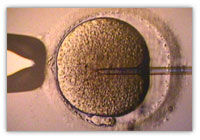Medically assisted reproduction brings together all medical procedures aimed at helping women become pregnant.
In Canada, it is estimated that between 10% and 15% of couples are infertile. From a medical point of view, infertility is defined as the inability of a couple to naturally conceive a child after one year of unprotected sex. Some of these couples then turn to adoption. Others instead use biotechnology to facilitate their ability to have one or more children. Indeed, various medically assisted procreation (or reproduction) techniques have been developed to help infertile or sterile couples to conceive a child.
It is important not to confuse infertility with sterility. Infertility refers to a couple's difficulty in conceiving, but not an impossibility. On the contrary, sterility is the permanent inability to conceive a child.
There are many causes of infertility or sterility. The most common cause is a problem during the production of gametes, either in terms of their quantity or their quality. Certain anatomical defects in the reproductive system or sexually transmitted infections (STIs) can also cause infertility. However, the causes of a couple's infertility often remain unexplained.
When a couple decides to turn to assisted reproduction to conceive a child, they must first undergo a fertility check-up. This assessment allows the doctor to determine the causes and the nature of the problem; this protocol allows the doctor to propose an adequate treatment. There are many medically assisted reproduction methods, but the following four are most commonly used.
Taking hormone-based medications can correct infertility caused by hormonal problems. Usually, this treatment is used for a woman who has no or very little ovulation. Taking hormones stimulates the onset of ovulation in women and promotes the growth of ovarian follicles in the ovaries, which will turn into eggs when they are expelled into the fallopian tubes. This treatment often causes multiple pregnancies since taking hormones stimulates the ovaries to produce more than one egg per cycle.
Hormonal treatments can also be called ovarian stimulation.
When there is a problem with the production of spermatozoa (sperm cells) (not enough or poorly formed), doctors often resort to artificial insemination. This technique, performed using a catheter (a very thin tube), consists in injecting sperm directly into the woman's uterus. We then say that fertilization takes place in vivo, that is inside the woman’s body.
Artificial insemination usually takes place in three stages. First, the mother undergoes hormonal treatment aimed at stimulating the ovaries and triggering ovulation on a specific date. Then the father's sperm (or the sperm of a donor in the absence of sperm cells from the father) is collected and processed. Only the best formed and most mobile sperm are kept. Finally, the doctor injects the treated sperm cells into the mother's uterus at the optimal time for fertilization, which is during ovulation. Although insemination is artificial, fertilization remains natural in this type of treatment.
Unlike artificial insemination, so-called in vitro fertilization takes place outside a woman's body. In fact, this technique allows the fertilization of eggs by sperm in the laboratory. Normally, it is used when attempts at artificial insemination have failed or when obstructed fallopian tubes are a barrier to natural fertilization.
In vitro fertilization takes place in several stages. First, the mother undergoes hormonal treatment aimed at stimulating the ovaries to produce a large number of eggs. Then, the father’s sperm (or that of a donor’s in the absence of sperm cells from the father) is collected and processed to ensure that only the best sperm is used. The mother's eggs are also collected during ovulation. Subsequently, the eggs are quickly brought together with the spermatozoa in a test tube or in a Petri dish. Fertilization therefore takes place in the laboratory. The fertilized eggs are in an environment that promotes the development of embryos. Two days after fertilization, doctors select the best-developed embryos (2 to 4) to be implanted in the mother's uterus so that at least one of them survives and gives rise to a pregnancy.
Babies resulting from in vitro fertilization are sometimes called test-tube babies, although their development takes place in the mother's uterus. Eggs fertilized in the laboratory and not implanted in the mother's uterus can be frozen for implantation later, if further in vitro fertilization is required.
Micro-injection fertilization is similar to in vitro fertilization. However, as a result of the collection of eggs and spermatozoa, these are not simply brought into contact in a test tube. Instead, a spermatozoon is forced into the egg with a micro-syringe. The resulting embryo will then be implanted in the mother's uterus, as in the case of in vitro fertilization. This technique is used when there are very few spermatozoa, which does not allow fertilization of the eggs even in a test tube.
Micro-Injection Fertilization
